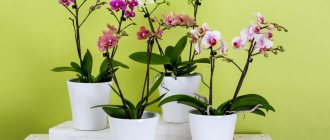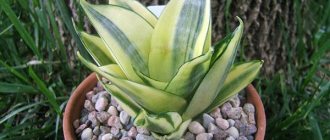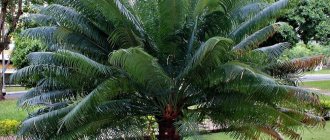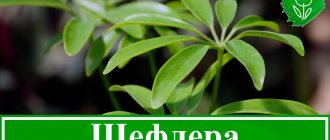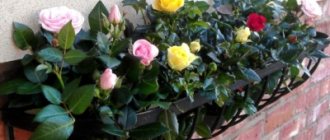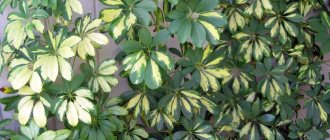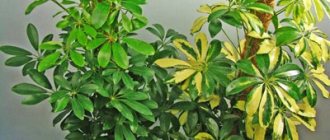Among the large indoor trees and shrubs that claim to be elegant, not a single crop can compare with the special type of Schefflera in the elegance and transparency of the crown. Unlike the much more popular and famous “zonulated” Schefflera, the most elegant one is a capricious plant, but does not require a cool winter. Like a bizarre vision, the crown of this plant consists entirely of lines and “strokes” of narrow leaves. Assessing the structure of the foliage at first glance is not easy, but Schefflera most graceful instantly gives the impression of a unique plant.
Schefflera elegantissima
Description
Schefflera (or Schefflera) is native to many countries with tropical climates. In nature, it grows in the form of a tree or shrub. There are species that reach a height of forty meters. These species are not suitable for indoor breeding. Many specimens in nature have more modest sizes, reaching two meters. In indoor conditions, the plant can reach one and a half meters. Therefore, the plant can be more often found in spacious halls, offices, and winter gardens. If space allows, then Schefflera can be successfully grown in an apartment, you just need to take into account its rapid growth.
It belongs to the Araliaceae family, and about 400 species grow in nature. The plant got its name from the name of the famous botanist Jacob Christian Scheffler from Germany. It is characterized by umbrella-shaped leaves, consisting of several dissected lobes. The number of lobes on a leaf ranges from 4 to 12, depending on the variety. The leaves are located on long petioles.
In nature, the plant blooms with inconspicuous small white flowers collected in an umbrella. It is not possible to achieve schefflera flowering indoors, but this does not upset flower growers. Because decorative leaves more than compensate for the lack of flowers.
Schefflera
A plant such as Schefflera or Schefflera belongs to the family called Araliaceae. In the wild, it can be found in the tropics in any part of the world. And most often it is found in Australia, China, the Pacific Islands and Japan. Wild-growing shefflera is not very large trees or bushes.
This plant is highly valued by flower growers for its beautiful, showy leaves, which are very similar to the human palm, the fingers of which are spaced far apart. The leaf blades are placed on a high petiole and are dissected into 4–12 lobes, which grow from the 1st point. In some countries, this flower is called the gnome umbrella or umbrella tree.
The elongated racemose inflorescences of this plant are very similar to tentacles or antennae. But you can only look at them in the botanical garden, and all because schefflera does not bloom in indoor conditions. But it can decorate any room thanks to its graceful shape and spectacular foliage.
This flower is very often grown as ficus benjamina, or rather, it is grown as a large house tapeworm plant, forming it in the form of a fairly large bush or tree.
The tall shoots of such a plant are not very thick, which is why several young sheffleras are often planted in one pot at once. And then they form a common stem (intertwined). If only one tall flower is planted in a pot, then a support is usually made for it.
This plant is quite easy to grow indoors and this is because it is completely undemanding and unpretentious. You need to care for it in almost the same way as other common house plants.
Types and varieties
The following types are used in indoor floriculture:
- eight leaf;
- radiate;
- tree-like;
- palmate.
Based on these species, breeders have developed new varieties of shefflera, which we will consider a little below.
Eight leaf
The plant got its name from the number of leaf blades, which ranges from eight to twelve. The leaves are lanceolate, pointed at the apex. Their length reaches 30-40 centimeters, and their width is about ten. The leathery leaves have several shades of green, and the veins on them are light cream.
Radifolia
Due to the shape of the leaf plate, it is also called star-leaved. You can recognize it by the number of leaves extending from the red-brown petiole. The sixteen leaves are ovoid at first. As the plant grows, they become longer, but remain blunt at the ends. Their length is fifteen centimeters and their width is five. The bright green leaves have a shiny leathery surface and light veins. This species is the most popular among gardeners. It is necessary to note the rapid growth of Schefflera radiata. Based on this species, varieties with yellow-green and golden-yellow leaf blades have been bred.
Tree-like
The plant is a tree that grows up to 1.2 m, with shoots extending from a straight trunk. This species is native to Southeast Asia. The number of leaves located on long petioles ranges from seven to sixteen. The leaves, which are up to fifteen centimeters long, reach eight centimeters in width. The size and shade of the leaves may vary depending on the variety.
Palmate
The homeland of palmate schefflera is New Zealand. In its homeland, the tree grows up to eight meters and resembles a palm tree. Eight ellipsoid-shaped leaves are on long petioles reaching twenty centimeters. The length of the leaves ranges from fifteen to thirty centimeters. It differs from the radiate species in its compactness.
This may be interesting: Stromantha - home care
Janine
Schefflera Janine stands out for its variegated foliage. Light dots and streaks are scattered on the dark green background of the leaves. This variety is distinguished by the fact that it tolerates shading well and does not lose its variegated color.
Nora
The Nora variety is variegated. Narrow green leaves are covered with yellow specks. The edge of the leaves is framed with teeth. Schefflera Nora is distinguished by its unpretentiousness and lush crown.
Gold Capella
The variety was bred on the basis of the tree-like Schefflera. The tree has a lush crown with bright green leaves covered with golden spots.
Gerda
The Gerda variety prefers diffused light, moisture and fertile soil. The leaves of the plant are variegated, yellow-green in color. The height of the plant depends on the conditions of detention, and varies from 0.5 to 2.5 meters.
Luzeana
The Luzeana variety is distinguished by openwork leaves with yellow-green streaks. Shiny leathery plates add additional decorativeness.
Bianca
Plants of the Bianchi variety have short leaves, the length of which does not exceed eight centimeters. The leaf blade has denticles along the edge, covered with a white border. Beige spots are visible at the base of the leaves. The variety is decorative due to the shape and color of the leaves.
Custer
This variety, bred by breeders, is more suitable than others for growing in our apartments. The plant does not grow more than 120 centimeters. Its leathery, dark green leaves are medium in size.
General information
There are more than 200 species in the Schefflera genus. Not all representatives of Schefflera are suitable for growing at home, since many of them in nature can grow up to 40 meters. Houseplants are much smaller, but with good care they can easily grow to the ceiling.
The flower tolerates shaping pruning well, so the gardener can give his plant absolutely any shape. Caring for shefflera is quite simple, so even novice gardeners will be able to cope with this unusual plant, growing a beautiful specimen that will be the envy of everyone.
Rules for caring for shefflera at home
Schefflera is unpretentious when grown indoors. But there are simple maintenance rules that will ensure the beauty and long life of the plant.
Lighting
Since the sheflera needs diffused light, the best place in the apartment will be the window sills of the eastern and western windows. On northern windows you can place Schefflera species with single-colored green leaves. In summer, it is recommended to take the pot with the plant to the balcony or loggia, but be sure to shade it from direct sunlight and protect it from drafts. In autumn and winter, the flower needs additional artificial lighting, especially when the room temperature is above eighteen degrees.
Temperature
Although Schefflera comes from the tropics, it does not like high temperatures. In summer, the ideal temperature for her would be twenty degrees Celsius. If the weather is very hot, the flower may shed its leaves.
In winter, the optimal temperature is in the range from fourteen to eighteen degrees. If the plant remains in a room with central heating in winter, then it is necessary to protect it from the dry warm air of radiators.
How to water
Schefflera prefers moist soil without drying out or waterlogging. Therefore, special attention should be paid to the regularity of watering. In summer, watering is carried out approximately once every two days, after the top layer of soil has dried. But at the same time, you need to water moderately to prevent stagnation of water in the soil. Stagnation of water leads to rotting of the roots. For irrigation, use only settled water at room temperature so that the temperature of the soil in the pot is not lower than the air temperature.
Schefflera prefers high ambient humidity. You can place the pot with the plant on wet expanded clay. Spraying is carried out every two days in the summer. Water for spraying should also be settled and warm. When kept in a room in winter, they also continue to spray or wipe the leaves with a damp sponge.
Top dressing
Regular, timely feeding promotes the growth and health of sheflera. Liquid complex fertilizers for decorative deciduous indoor plants are suitable for it. From spring to late autumn, sheflera is fed twice a month. You can feed with organic and mineral fertilizers, alternating them.
Important! It is not recommended to feed the flower with dry fertilizers.
The soil
Schefflera prefers light, nutritious, slightly acidic soil. To prepare it yourself, you need to take the following components:
- leaf soil (30%);
- turf land (40%);
- humus (20%);
- sand (10%).
This may be interesting: Yucca - reproduction, diseases and pests
You can prepare a soil mixture from turf soil, humus and sand, taken in a ratio of 2:1:1. But it’s still easier to buy a ready-made substrate at a flower shop. For cheflera, a mixture for growing ficus and palm trees is suitable.
Transplant and pot
Schefflera is replanted in the first half of spring. Young seedlings are planted several in one pot. Choose a pot for shefflera that is stable and quite deep, so that the drainage layer is two to three centimeters. Expanded clay and crushed brick are used for drainage.
When replanting a young plant, which is carried out after two years, a little earthen mixture is poured onto the drainage layer. Lightly shake off the soil from the roots, transfer the flower to a new pot and sprinkle the roots with soil. The soil is compacted and watered abundantly.
The next time you replant, each new pot should be four to five centimeters wider than the previous one. Large plants are replanted using the transshipment method, without shaking off the soil from the roots. The older the flower, the less frequently it is replanted. This is done when the roots have completely filled the pot.
Shefflera crown formation
A special feature of shefflera is its negative reaction to pruning. Cutting off a large number of shoots greatly weakens the plant, and it begins to hurt. Therefore, gentle pruning can be carried out only when necessary.
A young, rapidly growing plant is pruned to form side shoots. Trim the top shoot into four internodes. The cut is made with a sharp pruner or knife, but not with scissors. The cut area is sprinkled with activated carbon. After a year or two, you can shorten the side shoots to give the bush a spherical shape.
The best way to get a lush bush is to plant several cuttings in one pot. Cuttings after pruning are used for rooting and obtaining new young plants.
Shefflera propagation
Schefflera reproduces at home in several ways:
- cuttings;
- seeds;
- air layering.
Propagation by cuttings
For propagation, shoots cut off during pruning are used, or shoots are cut in the spring, choosing branches with partially woody stems. Cut with a sharp knife or pruning shears. The cut is treated with Kornevin or another drug that stimulates root formation. The cuttings are planted in soil consisting of peat and sand in equal parts. Before rooting, cover the top with a transparent bag and place it in a place with a temperature of 22 degrees. The film is periodically removed for ventilation, and finally removed after rooting. After the roots have formed, the temperature is lowered to eighteen degrees. When the roots fill the small containers in which the cuttings were planted, you can transplant the Schefflera into a larger pot with soil for adult plants.
Propagation by seeds
Start sowing seeds in mid-winter. The soil can be prepared in two ways. The first way is to mix sand and peat in equal parts. The second way is to take turf, leaf soil and sand in a ratio of 1:1:1. The mixture is pre-disinfected by heating in the oven for half an hour. The cooled soil is poured into the seedling boxes. A layer of drainage must be poured onto the bottom of the container.
Schefflera seeds are first soaked in water for two to three hours with the addition of Epin or Zircon. Then the seeds are planted, deepening them by five centimeters. The soil is moistened with a spray bottle and the container is covered with film. The boxes are placed in a warm place with a temperature of 22-24 degrees. Periodically remove the film for ventilation and spraying. Having a mini-greenhouse with bottom heating will speed up seed germination.
This may be interesting: Aglaonema - 20 popular species and varieties
After the first leaves appear, the seedlings are picked and transplanted into separate pots, lowering the temperature to 20 degrees. After three months, the sprouts are transplanted into a larger pot, planting several pieces per pot. Then the pot is placed in a room with a temperature of 14-16 degrees.
Reproduction by air layering
A new plant can be obtained using air layering. This method is used for adult flowers whose trunk has become woody. In early spring, before the growing season begins, a small incision is made on the trunk. It is covered with sphagnum moss soaked in a nutrient solution, which is prepared by dissolving one gram of complex mineral fertilizer in a liter of water. The trunk with moss is wrapped with film. Always ensure that the moss is kept moist. If there is no moss, you can use a bandage, moisten it and wrap it with film on top.
The appearance of roots is expected after two to three months. And after another three months, the branch with new roots is cut off and planted in a new pot. The cut site is left covered and continued to be moistened until new shoots appear. This is how the adult shefflera will be renewed.
Content
- General information
- Schefflera types and varieties
- Schefflera care at home
- Watering scheffleras
- Soil for shefflera
- Shefflera pot
- Shefflera transplant
- Fertilizer for Schefflera
- Schefflera flowering
- Schefflera pruning and shaping
- Schefflera in winter
- Propagation of shefflera by cuttings
- Schefflera from seeds at home
- Reproduction of Schefflera by air layering
- Schefflera propagation by leaf
- Diseases and pests of Schefflera
Schefflera diseases
Many people wonder what to do if the leaves of the sheflera fall off? The plant, despite its unpretentiousness, reacts negatively to high and low temperatures, sudden temperature changes, waterlogging and drafts, and lack of light. The reaction to many external stimuli in a tropical flower is the same - the shefflera sheds its leaves. Therefore, it is necessary to carefully analyze the conditions of detention in order to determine and eliminate the cause of leaf fall. When conditions improve, the plant stops shedding leaves, and over time its decorative appearance will be restored.
It is more difficult to cope with root rot, which occurs with frequent waterlogging and keeping at low temperatures. Rot is manifested not only by the withering and falling of leaves, but also by the appearance of black spots on them. If such symptoms of the disease occur, remove the plant from the pot and check the condition of the roots. Damaged, diseased roots are removed. Then the root system is immersed in a weak solution of potassium permanganate for twenty minutes to disinfect, and then planted in a new pot and new soil. The old pot must be disinfected before reuse.
- Excessive watering can be manifested by the appearance of small bubbles on the underside of the leaf blade. This disease is called "dropsy".
- Direct sunlight can cause yellow spots to appear on the leaves. With a lack of light, the leaves turn pale, especially variegated varieties lose their decorative effect.
- The tips of the leaves turn brown and dry out if there is insufficient watering or low ambient humidity.
Pests
Schefflera is attacked by pests of indoor plants such as spider mites, thrips and scale insects. Spider mites are noticeable by a white coating on the leaves and internodes, similar to small cobwebs. The scale leaves a sticky coating, and the insects themselves can be seen in the form of small brown tubercles on the leaves. Thrips can be detected by black dots on the back of the leaf blade.
Spider mite Thrips
Shchitovka
If the number of pests is small, you can use traditional methods:
- wash the leaves with soapy water;
- soak a cotton swab in alcohol and wipe the leaves where insects are found.
If these methods do not lead to the destruction of pests, then it is necessary to treat the plants with insecticides such as Aktara. After a week and a half, the treatment should be repeated.
